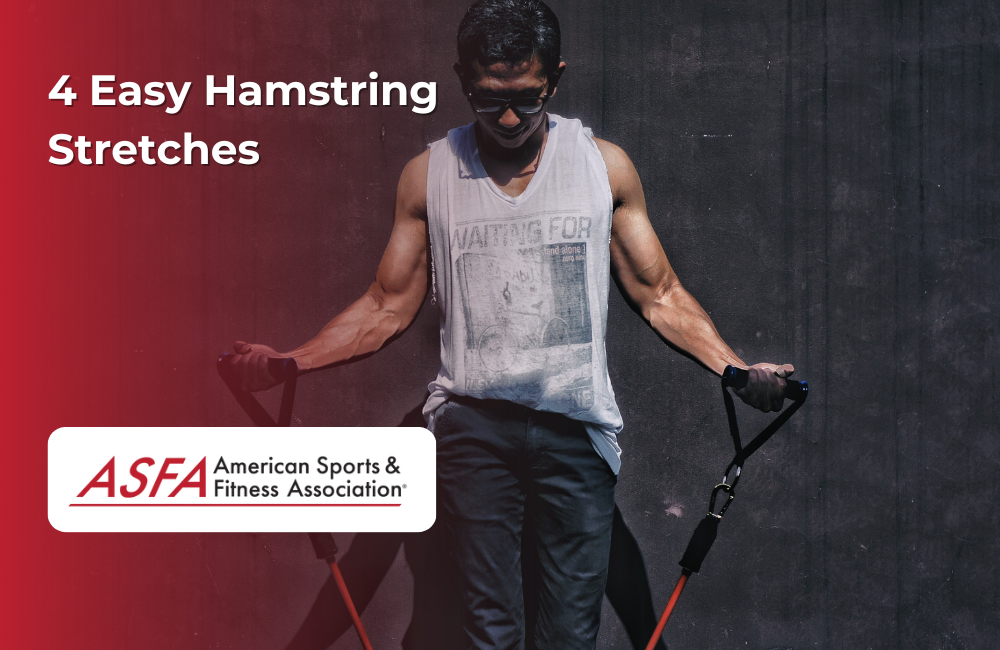Hamstring stretches play a vital role in improving flexibility, reducing injury risk, and enhancing overall sports performance. An example of an easy hamstring stretch is the standing forward bend, which harnesses the assistance of gravity to enhance the stretch. These stretches can be performed using minimal equipment and in various positions to target different parts of the hamstring muscle. Here's an in-depth look at four effective hamstring stretches, along with detailed instructions and benefits.
The Importance of Simple Hamstring Stretches
Definition of Hamstring Stretches
Hamstring stretches are exercises specifically designed to lengthen and relax the hamstring muscles, which run along the back of the thigh from the hip to the knee. These stretches play a crucial role in improving flexibility, reducing muscle tension, and preventing injuries. There are two main types of hamstring stretches: static and dynamic. Static stretches involve holding the muscle in a stretched position for a period of time, while dynamic stretches involve moving the muscle through a range of motion to achieve a stretch. Incorporating both types of hamstring stretches into your routine can help maintain the health and flexibility of your hamstring muscles.
Flexibility
-
Enhanced Range of Motion: Increases the flexibility of the hamstring muscle, allowing for a greater range of motion in the hips and legs. Improving hamstring flexibility can relieve tight muscles or pain in the back of the thigh and is essential for a comprehensive treatment plan.
-
Improved Posture: Regular stretching helps maintain good posture by balancing muscle tension across the lower back and legs.
Injury Prevention
-
Reduced Risk of Strains:Flexible hamstrings are less prone to strains and injuries, especially during physical activities. Tight hamstring muscles pull on the pelvis and lower back, leading to a posterior pelvic tilt and flattening of the lower back arch, which can contribute to lower back pain.
-
Muscle Balance: Helps maintain muscle balance around the knees and hips, reducing the likelihood of injuries.
Performance Enhancement
-
Increased Athletic Performance: Flexible hamstrings contribute to better performance in sports and physical activities.
-
Efficient Movement: Enhances the efficiency of movements, making activities such as running and jumping more effective.
Causes and Effects of Tight Hamstrings
What Causes Tight Hamstrings?
Tight hamstrings can result from various factors, each contributing to the shortening and stiffening of these muscles. One common cause is prolonged sitting, which can lead to shortened hamstrings due to the constant bent position of the legs. Poor posture also plays a significant role, as it can place undue strain on the hamstrings, leading to tightness and discomfort. Additionally, inadequate stretching routines can cause the hamstrings to lose flexibility over time. Muscle imbalances, such as weak glutes or tight hip flexors, can further exacerbate the problem by placing additional stress on the hamstrings.
How Tight Hamstrings Affect Daily Activities
Tight hamstrings can significantly impact your daily activities, making even simple movements challenging. Reduced mobility is a common issue, as tight hamstrings can limit the range of motion in your knees and hips, making activities like walking, running, or climbing stairs more difficult. Pain is another frequent symptom, with discomfort often felt in the back of the thigh. This pain can be both uncomfortable and debilitating, affecting your overall quality of life. Additionally, tight hamstrings can contribute to poor posture, which can lead to further strain on your back and other muscles, creating a cycle of discomfort and limited mobility.
Common Signs of Tight Hamstrings
Recognizing the signs of tight hamstrings is the first step towards addressing the issue. Common symptoms include stiffness in the back of the thigh, which can make movements feel restricted and uncomfortable. Pain or discomfort in this area is also a clear indicator, often exacerbated by physical activity. Limited mobility in the knee or hip joints is another sign, making it difficult to perform everyday tasks. Poor posture, often resulting from the strain tight hamstrings place on the lower back, is another symptom to watch for. Additionally, muscle cramps or spasms in the back of the thigh can signal that your hamstrings are overly tight and in need of stretching.
By understanding the causes and effects of tight hamstrings, you can take proactive steps to prevent and alleviate tightness, ultimately improving your overall flexibility and mobility. Regular hamstring stretches, combined with proper posture and balanced muscle strength, can help keep your hamstrings healthy and functional.
Detailed Hamstring Stretches
1. Seated Hamstring Stretch
The seated hamstring stretch is an effective way to target the hamstrings while in a seated position.
Sit on the ground or a firm surface, such as a bench or chair:
-
Extend one leg straight out in front of you with your toes pointing up.
-
Keep the opposite leg bent or flat on the ground if seated in a chair.
Hand Placement:
-
Place your hands on the opposite thigh or gently reach towards your extended foot.
Lean Forward:
-
Lean forward from the hips, keeping your back straight.
-
Move forward until you feel a gentle stretch in your hamstring.
-
Keep your knees slightly bent to maintain comfort and achieve a better stretch, especially if you have tight hamstrings.
Hold:
-
Maintain this position for 15-30 seconds, ensuring not to overstrain the muscle.
Switch Legs:
-
Repeat the stretch with the other leg.
Alternatively, you can try the towel hamstring stretch. Use a towel as a prop to improve hamstring flexibility and prevent any potential pain or discomfort during the exercise.
-
Flexibility: Enhances flexibility in the hamstrings and lower back.
-
Posture: Promotes a straight back, reducing the risk of lower back pain.
2. Standing Hamstring Stretch
The standing hamstring stretch is perfect for those who prefer stretching while standing.
-
Stand upright and place one heel on an elevated surface, such as a small bench, step, or curb.
-
Toe Position:
-
Point your toes upwards and hold the position for a few seconds.
-
The higher you lift your toes, the deeper the stretch.
-
Lean Forward:
-
Slightly lean forward from the hips to intensify the stretch.
-
Switch Legs:
-
Repeat the sequence with the opposite leg.
-
Deeper Stretch: Provides a deeper stretch with elevated toes, enhancing flexibility.
-
Convenience: Can be performed anywhere with an elevated surface.
For those who prefer a different approach, the lying hamstring stretch is another effective method, especially beneficial for beginners and individuals with chronic lower back pain or disc disease. This stretch helps ease and prevent back pain, particularly for those with tight hamstrings.
3. Hamstring Stretch on Wall
This stretch targets the hamstrings from a different angle, utilizing a wall for support.
Lie flat on your back with your feet towards a wall.
Leg Placement:
-
Place one leg up against the wall, ensuring your heel has good contact.
-
The other leg should remain flat on the floor.
Toe Position:
-
Raise your toes and dig your heel into the wall.
Hold:
-
Maintain the position for 15-30 seconds, feeling the stretch along the back of your leg.
Switch Legs:
-
Repeat with the other leg.
-
Alternative Angle: Targets the hamstrings from a different position, providing variety.
-
Lower Back Relief: Reduces tightness in the lower back by stretching the hamstrings.
-
Static Hamstring Stretches: Static hamstring stretches help improve flexibility and can be made dynamic by incorporating repeated movements within a specific time frame.
4. Lying Hamstring Stretch
The slump hamstring stretch is best performed while seated, focusing on the entire posterior chain. Start by positioning your left foot correctly to ensure balance and proper form.
Sit on a chair or bench with one leg extended out in front of you.
Upper Body Position:
-
Slump your head and shoulders forward while maintaining a straight lower back.
Toe Position:
-
Point and lift your toes towards your body.
Using an Exercise Band:
-
For a deeper stretch, place an exercise band around the arch of your foot and gently pull back.
Hold:
-
Maintain the position for 15-30 seconds.
Switch Legs:
-
Repeat with the other leg.
Incorporating hamstring stretching exercises can relieve tightness and improve flexibility in the hamstrings, which is beneficial for individuals experiencing lower back pain, leg pain, stiffness, aching, or burning in the back of the thigh.
Benefits:
-
Full Chain Stretch: Targets the entire posterior chain, including the hamstrings, lower back, and calves.
-
Improved Posture: Helps in correcting posture by stretching the spinal muscles.
Additional Tips for Effective Stretching for Tight Hamstrings
Seek Professional Guidance
-
Certified Trainers: Work with a certified fitness professional to ensure you perform exercises correctly and safely. A physical therapist can evaluate your symptoms, offer treatment plans, and show ways to improve hamstring flexibility.
-
Personalized Programs: Trainers can tailor stretching routines to your specific needs and goals.
Consistency and Safety
-
Incorporate these stretches into your daily routine to see consistent improvement.
-
Avoid Over-strain: Stretch gently to avoid muscle strain or injury.
-
Warm-Up: Always perform a proper warm-up before stretching to prepare your muscles.
-
Manage Body Weight: Pay attention to your body weight during stretches to avoid strain. For example, in the 'Legs Up the Wall' position, managing your body weight can minimize pressure on the hamstrings and lower back.
Utilizing Online Resources
-
Certified Wellness Coaches: Online programs can provide valuable tips, demonstrations, and personalized recommendations for stretching.
-
Instructional Videos: Use instructional videos to ensure you're performing each stretch correctly.
Benefits of Regular Stretching
Improved Flexibility
-
Muscle Elasticity: Regular stretching enhances muscle elasticity, allowing for greater flexibility.
-
Joint Mobility: Helps in maintaining and improving joint mobility.
Enhanced Performance
-
Athletic Performance: Flexible muscles contribute to better athletic performance by allowing for more efficient movements.
-
Daily Activities: Improved flexibility makes daily activities easier and less strenuous.
Injury Prevention
-
Reduced Muscle Strain: Stretching helps prevent muscle strains and other injuries by keeping muscles supple. When performing stretches, focus on bending or raising the right knee to achieve deeper stretches and reduce the risk of injury. Tight hamstrings can contribute to lower back pain and poor posture, making it essential to address this issue through regular stretching.
-
Balanced Muscle Tension: Maintains a balance of muscle tension across different muscle groups, reducing the risk of injury.
Incorporate these detailed hamstring stretches into your fitness routine to improve flexibility, enhance performance, and reduce injury risk. Regular practice, proper form, and professional guidance can help you achieve the best results. For personalized assistance, consider consulting a certified fitness professional or utilizing online resources from certified wellness coaches.





